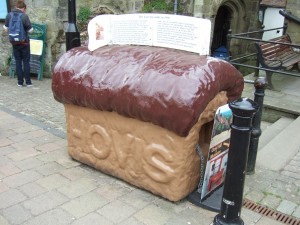Watching the first stage of the Tour de France travelling through Yorkshire today reminded me of what I had always thought of as one of the most ‘Yorkshire’ television ads of all time: a young lad pushes his bike up a cobbled hill, on his way to deliver a basket full of Hovis bread loaves, while a brass band plays Dvořák’s New World Symphony (Symphony No. 9). The advert was directed by Ridley Scott in 1973. A few years later he went on to start his movie directing career with The Duellists and then Alien. The advert was voted the nation’s favourite in a poll a few years ago (albeit in a poll of just 1,000 people!).
However, my memory has failed me—I had always remembered it as being voiced by a man with a Yorkshire accent. I think the brass band would certainly have added to the general impression of ‘Northern-ness’. On re-watching it the voiceover is by a man with a West Country accent, and so is perfectly fitting for the location: Gold Hill in Shaftesbury, Dorset.
We live in the south-west corner of Wiltshire, so we spend a lot of time in the neighbouring counties of Somerset and Dorset. One of our nearest shopping towns is the Saxon hilltop town of Shaftesbury. 41 years on, Gold Hill is still known as ‘where they filmed that Hovis ad’, and a giant Hovis loaf stands outside the Town Hall, a collecting box for money to go towards the restoration of the Hill. Many of the older buildings in Shaftesbury are built with the green-coloured and well-named greensand stone.
There were two other Hovis ads using the same music and a Yorkshireman doing the voiceover, which might help to explain my confusion:
and the first one in this sequence, with a boy walking up a cobbled hill (with his Mum):
Hovis do a nice line in ‘nostalgia’ advertising, and in 2008 they made a fantastic and very moving ad, celebrating 122 years of Hovis and British history:
They get an extra ‘yay’ from me for including the fight for Women’s Suffrage and the miner’s strike, as well as the brave men and women of both World Wars. Four years later Danny Boyle did something similar, but on a far grander scale—but that’s for another blog post!


